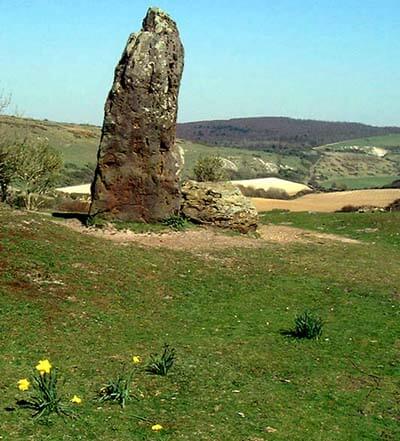Longstone, Mottistone. Ghosts of the Isle of Wight, with Margo Williams

Everything Happens for a Reason
A CRACKED GLASS VASE lay on the grassed bank beside a secluded natural pool in the Isle of Wight. Shaded by trees in a pretty vale near the standing stone megalithic monument known as the Longstone.
In summer months the pool transforms into an oasis of waxy-pink water-lilies where dragonflies buzz and butterflies flutter and a bachelor heron finds peace among the wild flowers.
A pool haunted by a ghost, to whom the glass vase belonged. I picked it from the ground, but too late noticed the grievous crack in its delicate fluting and base; the vase fractured into pieces like fragile eggshell.
‘Everything happens for a reason’, is an old saying.
Some people interpret its meaning by looking into the past for the cause of any effect.
Other people find meaning in the present; a wisdom of the now to be appreciated when anything happens. For example, understand by its passing from vase to fragment form is a lesson that change is inevitable; nothing lasts for ever.
Some people anticipate a reason for why things happen to be somewhere in the future: the event serves a hidden greater purpose; a pre-determined plan, or destiny if you like.
A Tool For Understanding
The saying is as ancient as philosopher Aristotle, the wise Father of Statistics. ‘Everything happens for a reason’ is a useful tool for understanding our world.
That crack weakened the structural integrity in the vase; damage in turn caused by stress or impact; tipping-point pressure of my fingertips caused it to break.
Less obvious, in a cause and effect understanding is the reason why the vase lay on the ground by the pool in that remote country place.
‘Someone left it there,’ is all we can know.
The same tool can be applied to other local mysteries, including the origin of the giant Longstone - or ‘Druid stone’ - and its recumbent partner beside it.

The stratified iron sandstone chunks were dug away from the nearby sea cliffs and transported into position. Why? is unavailable information.
Or the clusters of human-made mounds that pimple the chalk ridge-line above: altitude was a deliberate choice is the obvious cause and effect answer for placement up there.
Why? however, remains a mystery; even after the barrows were opened up and plundered by grave robbers.
No one ever found much more than pottery and bones, human and animal; which led to the obvious conclusion of funerary monuments; though evidence of phased activity suggested continuous use.
However, those objects provided opportunity for carbon dating, which confirmed barrow appearances in the landscape began around 3800 BC; coincidental with the construction of Stonehenge, and the Great pyramids of Egypt.
The Railway Accident
“Everything happens for a reason,” said a friend to console me, on learning that I had lost my senses of taste and smell.
“Mumbo Jumbo,” said my husband. Chemical cause and effect, he and his fellow scientists would agree, but it was a mystery to the local doctor in Ventnor who injected me with cortizone and suggested that might work to restore those missing senses.
Perhaps it did, but it didn’t for a long uncomfortable time. Years passed without tasting an apple or smelling a rose; but when those senses returned, as mysteriously as they vanished, the thrill of restoration felt so good I didn’t notice the unexpected bonus they brought back with them, until a ghost spoke to me.
“What did you hear?” asked Walter, my husband, anxious to know what the ghost of the pool had said. I gazed at the piece of paper in my hand; stared at the curious joined-up writing that spread over both sides. The short history of a de.d man and his family.
“They died in a train crash,” I replied.
“Where?” was Walter’s next question.
“He didn’t say,” I answered, sifting through the pieces of glass vase wondering if they were reparable or best taken to a recycling bin. Then read again what I had written as dictation from the ghost.
He told me the story of his de.th; catastrophic, thanks to cause and effect in the Railway.
“...I met Molly at a dance,” said the ghost of the pool. “We knew we were made for each other. We were dancing to the tune “My Blue Heaven”. It was wonderful. We married and came here on honeymoon. We loved it.
A year later our baby was born, a dear little girl. We brought her to this magical place. Molly wore a beautiful blue dress, a lovely blue. We called the place by the pool our Blue Heaven and planned that when we died we would meet here. How true a silly remark turned out to be.
I tried to lead a good life. I enjoyed the odd pint of beer and my old pipe, with a few cigars at Christmas. That was my weakness. My life was for Molly and the child. We were so deeply in love and always singing “My Blue Heaven”. We hoped we would all die together. We did. K.lled in a rail crash on the mainland.
We found ourselves in our blue heaven around the pool and enjoying our self-contained afterlife. It has been a real heaven, but now we all wish to go onwards.”
He paused on that request, before telling me why he still was holidaying in the Isle of Wight.
“I had to wait and tell someone how wonderful it has been. Real love, that is true, has brought us happiness and is everlasting. We will leave the pool for others who will come. I am very strong and will show you something to remind you of true love.
Never look for perfection in anyone, as we all have a flaw or crack in our nature. I know some people reach their blue heaven. Thank you for listening.”
That was all he said.
My Blue Heaven
Molly’s husband offered little by way of information to place him among the living. No surname, or first name; only the title of a song and a de.th in a train.
“My Blue Heaven” was a popular song in the 1920s, Gene Austin recorded it in 1928. Railway company records list two rail crashes in that year, one in Gloucestershire on October 13th; a fireball train-wreck that raged for hours rendering unidentifiable the 15 de.d; among whom were two unknown children.

The other rail disaster happened in Darlington during the summer, when an excursion train was derailed by an impact from a parcel train; it caused telescoping of rear carriages into the front three, k.lling many passengers.
The gas lighting system remained intact, sparing more de.th by fireball but 25 people lost their life in that evening catastrophe.
It is impossible to confirm which, if either, happened to be the ghost’s train without a name or anything else by which to identify. Not enough information to prove he and his family ever lived at all; if indeed it was a ghost and not my imagination.
Initially, Walter didn’t believe in ghosts; a scientist, he insisted on the “Everything is chemistry” explanation for my loss of taste, smell and unexpected auditory upgrade. An effect caused by the menopause, he said; an hallucination.
Identifying the De.d
When some ghosts offered details of their lives, more than Molly’s husband provided that day, Walter investigated to prove his point.
However, when information turned up to confirm these people had lived, and that evidence lay buried too deep and inaccessible for me to find beforehand, his need-to-know curiosity took over.
When ghosts led us to find lost objects in remote places, he conceded that ‘something supernatural’ was the only possible explanation. In time he gathered sufficient evidence to present his findings to fellow scientists at the Royal College of Science, and when done, the case for personality survival after death looked proven.
Ghosts have haunted humankind ever since anyone can remember; probably even long before the Longstone was first eased into its current upright position. Local archaeologists suggest the mysterious megalith formed part of a graveyard facility, a dolmen burial chamber.
Mythologists offer meaning for its purpose, suggesting it was regarded as a vehicle, a ‘ship’ to carry the dead up to the stars above. A means of transportation. The ghost of the glass vase and his family boarded a train but didn’t reach their destination.
The accident happened for a reason: driver error; signalling failure; dangerous materials and high speed but instead they arrived at a dream holiday destination on the Isle of Wight.
It is impossible to confirm where his and his family’s remains lay buried but fair to assume a priest spoke the sacred words of farewell as their bodies lowered into their grave, “Ashes to ashes, Dust to dust.”
Somewhere in a graveyard is a gravestone of a family who d.ed in a train crash.
Thank you for your company on this short tour of Isle of Wight mysteries and haunting. If you would like to know more about Margo Williams' investigations at the Longstone and other matters of destiny and desire, read this book. Now available from Amazon.
